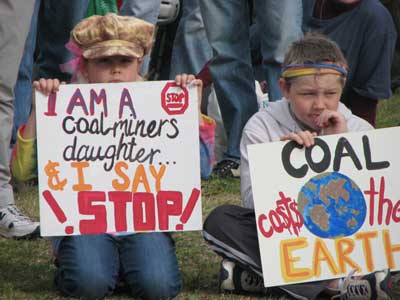Recently I visited Lithgow, partly to see how the area just south of it compared to the Hunter Valley, since both are now threatened with a third power station, also likely to be coal-fired.
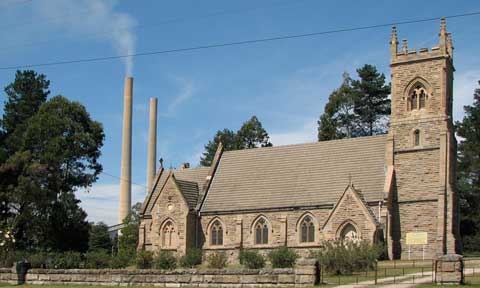 At Wallerawang power station the village of the same name is extremely close by, as the church shows. I wonder if the residents are aware of the toxic contents of those plumes of smoke? In the Hunter, Ravensworth, once probably the closest village to those power stations, is now obliterated, the abandoned school the only testament that once it thrived.
At Wallerawang power station the village of the same name is extremely close by, as the church shows. I wonder if the residents are aware of the toxic contents of those plumes of smoke? In the Hunter, Ravensworth, once probably the closest village to those power stations, is now obliterated, the abandoned school the only testament that once it thrived.
South of Wallerawang, between that and the Mt Piper Power station, with a 200MW extra power station planned just 2 km away, is the village of Blackmans Flat. It reminded me of Camberwell in the Hunter — being choked out of existence by coal.
Blackmans Flat only has 13 houses, but they are surrounded by open cut and underground mines plus a power station fly-ash dump, all blaming each other for the dust, noise and blasting cracks.
With more open cut mines in the wings, and a new 10 million tonne fly-ash dump proposed to be placed 800m from the village, and Lithgow Council’s Regional Garbage dump proposed to be 600m away — how much more can these villagers take?
 Why doesn’t the government take the cumulative effects of these approvals into account? It must seem to Blackmans Flat residents that it’s because people don’t count.
Why doesn’t the government take the cumulative effects of these approvals into account? It must seem to Blackmans Flat residents that it’s because people don’t count.
In the village cemetery I see that people have lived here for over a hundred years. With the health hazards that surround them now, and worse looming, I fear for the village and its residents. But how can they leave, for who would buy their houses?

 As the valley fills with dust and noise, the cliffs split and fall away and the filtering hanging swamps drain dry through the cracks from undermining, we must remind ourselves that all these operations are under ‘strict environmental guidelines’.
As the valley fills with dust and noise, the cliffs split and fall away and the filtering hanging swamps drain dry through the cracks from undermining, we must remind ourselves that all these operations are under ‘strict environmental guidelines’.
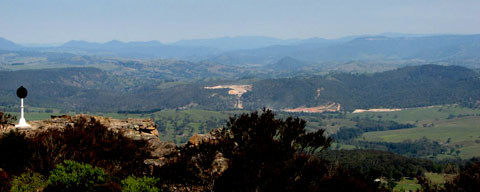 I wonder if Lithgow Council, who support the third power station, know what they are allowing to happen to their scenic region and its inhabitants. While underground mines currently dominate here, unlike the Hunter’s open-cut moonscape, the pollution and the destructive impacts are increasing and so are the mines.
I wonder if Lithgow Council, who support the third power station, know what they are allowing to happen to their scenic region and its inhabitants. While underground mines currently dominate here, unlike the Hunter’s open-cut moonscape, the pollution and the destructive impacts are increasing and so are the mines.
As my bumper sticker says, ‘Coal costs the earth.’
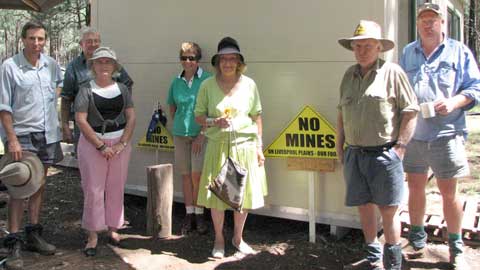 Trish Duddy and Tommy and George Clift (front L to R, all hatted) have been at the blockade camp every single one of those 615 days, joined by other locals on a rolling roster for cups of tea, information swapping, resolve steeling — and symbolic trailblazing.
Trish Duddy and Tommy and George Clift (front L to R, all hatted) have been at the blockade camp every single one of those 615 days, joined by other locals on a rolling roster for cups of tea, information swapping, resolve steeling — and symbolic trailblazing. I had driven in to the Blockade that morning, looking south across the Plains to the polluted and dust-laden skies of the Hunter Valley, where the government has allowed every coal company to win every battle. Down there it is the wineries and thoroughbred horse studs now protesting that their industries cannot cope with any more coal mines.
I had driven in to the Blockade that morning, looking south across the Plains to the polluted and dust-laden skies of the Hunter Valley, where the government has allowed every coal company to win every battle. Down there it is the wineries and thoroughbred horse studs now protesting that their industries cannot cope with any more coal mines. The difference when I looked north, away from the coal-trashed Hunter, is obvious – clear blue skies as country skies should be, not murky brown. I admired the vast patchwork of ploughed land and crops, with the rusty red of sorghum seed-heads, the green of new crops, the cream of harvested stubble and the rich dark soil itself.
The difference when I looked north, away from the coal-trashed Hunter, is obvious – clear blue skies as country skies should be, not murky brown. I admired the vast patchwork of ploughed land and crops, with the rusty red of sorghum seed-heads, the green of new crops, the cream of harvested stubble and the rich dark soil itself.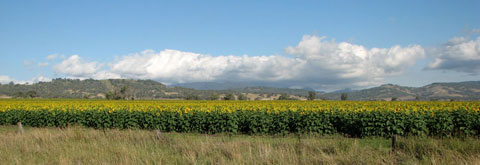 Later that day, heading towards the hills and home, I pass incredibly flat golden vistas of sunflower heads and their vibrant green plants and I am struck by its ‘livingness’ as I think of the appalling contrast I will meet back as I drive back into the Hunter.
Later that day, heading towards the hills and home, I pass incredibly flat golden vistas of sunflower heads and their vibrant green plants and I am struck by its ‘livingness’ as I think of the appalling contrast I will meet back as I drive back into the Hunter.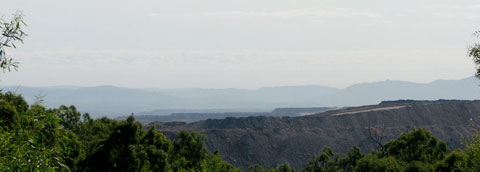 Vistas of dirt and coal, an industrial hell, a dead landscape, seen through the veil made by one of the highest concentrations of fine dust particulates in Australia. I hope the Caroona farmers manage to stop this happening to their Plains — and after speaking to many of them I believe they will!
Vistas of dirt and coal, an industrial hell, a dead landscape, seen through the veil made by one of the highest concentrations of fine dust particulates in Australia. I hope the Caroona farmers manage to stop this happening to their Plains — and after speaking to many of them I believe they will!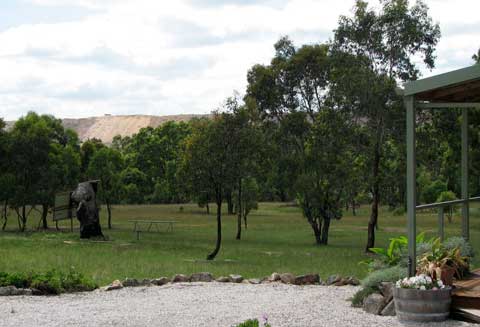 North of Mudgee, NSW, I recently visited such a home. It now has a new open-cut coal mine as a neighbour that can’t be ignored. That huge wall of overburden (the dirt and rock they dig up to get at the coal) is just 400 metres from their house, rising beside the small creek in the treeline. You can just see the top of one of the giant trucks operating there.
North of Mudgee, NSW, I recently visited such a home. It now has a new open-cut coal mine as a neighbour that can’t be ignored. That huge wall of overburden (the dirt and rock they dig up to get at the coal) is just 400 metres from their house, rising beside the small creek in the treeline. You can just see the top of one of the giant trucks operating there.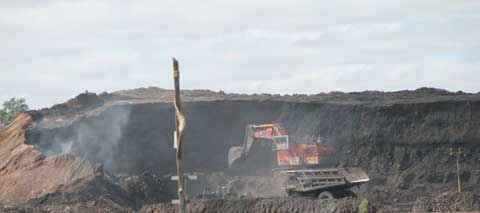 I travel south to see another mine in the region, down a pot-holed dirt road with mine vehicles hurtling along it at speeds that make me pull over to get out of the way.
I travel south to see another mine in the region, down a pot-holed dirt road with mine vehicles hurtling along it at speeds that make me pull over to get out of the way.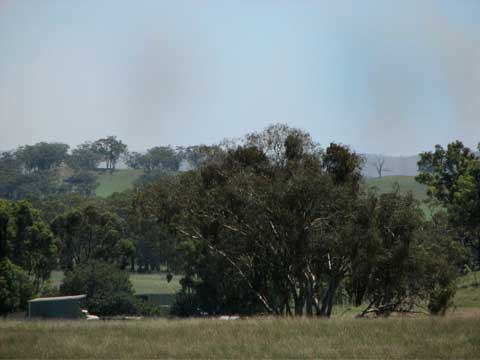 I leave the mines behind and head down a dirt road in what seems a green and still rural valley to find a spot to have my picnic lunch. It is quiet enough, but then over the green hills I see dust rising; I have not gone far enough to escape the effect of the open-cut, although the mine would probably have classed this valley as beyond its ‘area of affectation’.
I leave the mines behind and head down a dirt road in what seems a green and still rural valley to find a spot to have my picnic lunch. It is quiet enough, but then over the green hills I see dust rising; I have not gone far enough to escape the effect of the open-cut, although the mine would probably have classed this valley as beyond its ‘area of affectation’. 
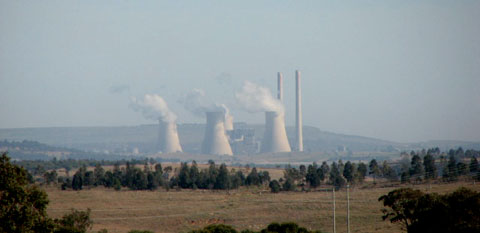 Under the murky skies of the Hunter Valley, despite its dominance by coalmines and coal-fired power stations, some culture does exist!
Under the murky skies of the Hunter Valley, despite its dominance by coalmines and coal-fired power stations, some culture does exist!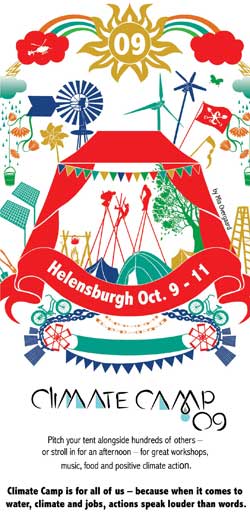 For three days in October, from Friday 9th—Sunday 11th, I’ll be camping in my little tent alongside hundreds of others at Climate Camp ’09 .
For three days in October, from Friday 9th—Sunday 11th, I’ll be camping in my little tent alongside hundreds of others at Climate Camp ’09 . 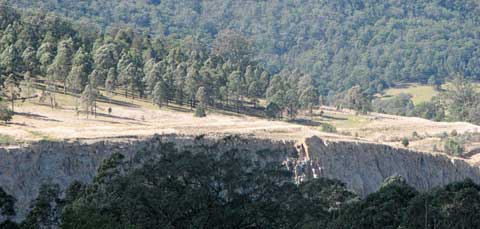 Many farms, like the one below, have already been bought up for hard-to-resist prices; across other paddocks we could see dozens of test drill pipes under their white caps.
Many farms, like the one below, have already been bought up for hard-to-resist prices; across other paddocks we could see dozens of test drill pipes under their white caps.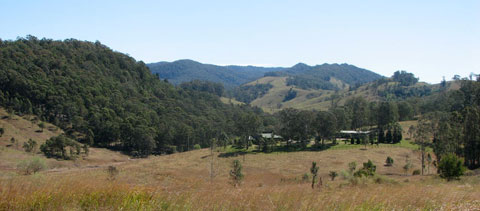 This region is watered by pristine rivers and creeks that rise in the nearby World Heritage sub-alpine Gloucester and Barrington Tops. And yet the mine wants to discharge its toxic waste water into these streams.
This region is watered by pristine rivers and creeks that rise in the nearby World Heritage sub-alpine Gloucester and Barrington Tops. And yet the mine wants to discharge its toxic waste water into these streams.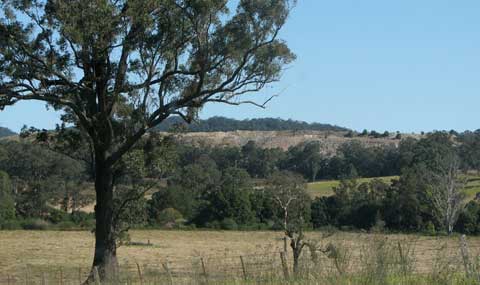 These gullies run into Mammy Johnsons River (below), which flows to the Karuah River and thence to the tourist and marine environment mecca of Port Stephens.
These gullies run into Mammy Johnsons River (below), which flows to the Karuah River and thence to the tourist and marine environment mecca of Port Stephens.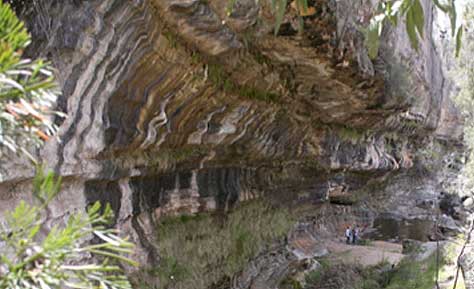 ‘The Drip’ in Goulburn River National Park under threat from mining; get the scale of its grandeur from the two figures at its base.
‘The Drip’ in Goulburn River National Park under threat from mining; get the scale of its grandeur from the two figures at its base.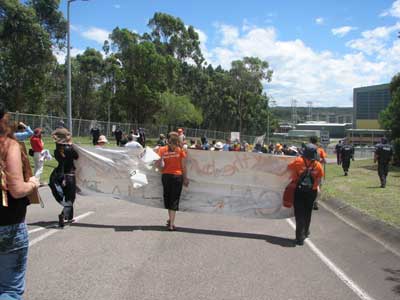
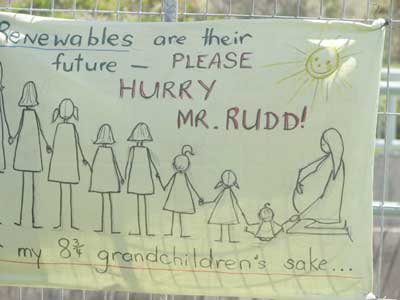
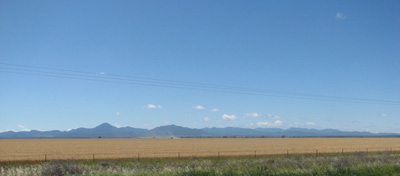

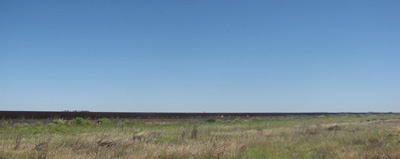
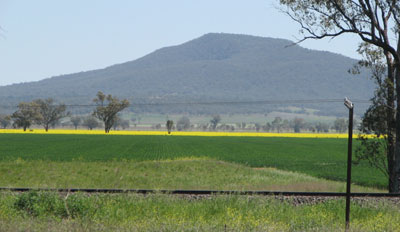
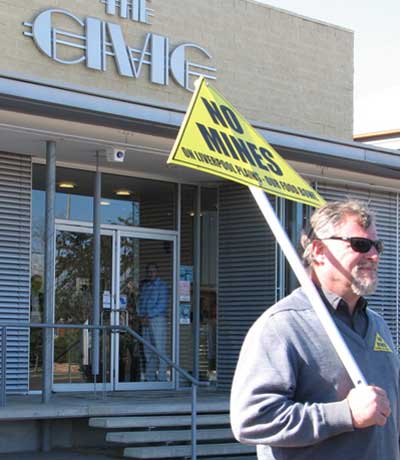
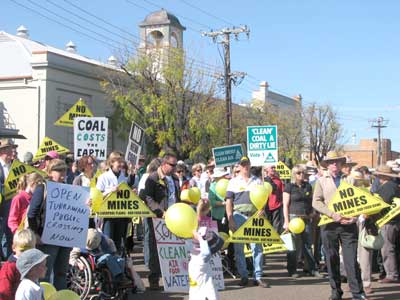
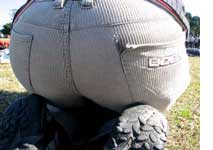 And there was action. On the Saturday hundreds more concerned people joined us. We crouched down to form a human sign – ‘Cut carbon — now or never’ and a human ticking clock, which caused us to leap up and ‘explode’ over the oval at ‘midnight’. If you weren’t in the helicopter it wasn’t much of a photo opportunity, except for the rear end of the person in front!
And there was action. On the Saturday hundreds more concerned people joined us. We crouched down to form a human sign – ‘Cut carbon — now or never’ and a human ticking clock, which caused us to leap up and ‘explode’ over the oval at ‘midnight’. If you weren’t in the helicopter it wasn’t much of a photo opportunity, except for the rear end of the person in front!